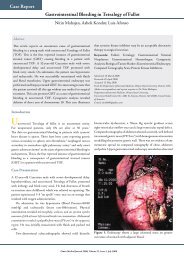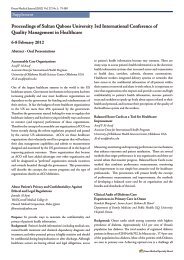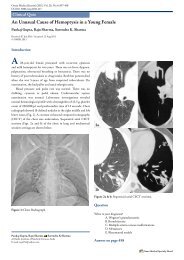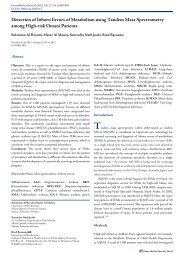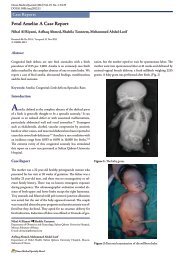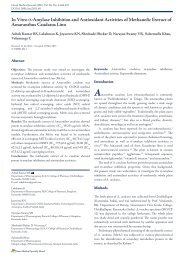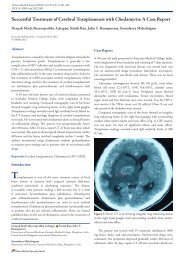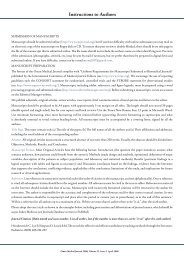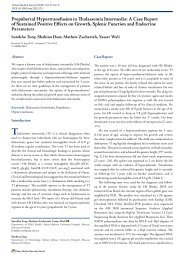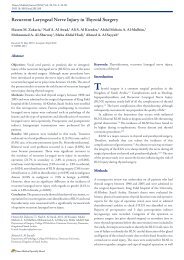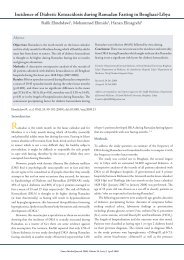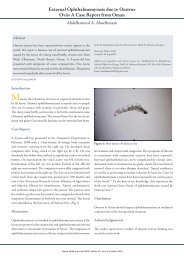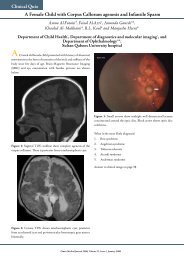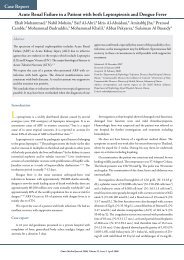Case of Neurosyphilis Presented as Recurrent Stroke - OMJ
Case of Neurosyphilis Presented as Recurrent Stroke - OMJ
Case of Neurosyphilis Presented as Recurrent Stroke - OMJ
You also want an ePaper? Increase the reach of your titles
YUMPU automatically turns print PDFs into web optimized ePapers that Google loves.
stroke. The patient w<strong>as</strong> started on Crystalline Penicillin at a<br />
dose <strong>of</strong> 3 million units every four hours with careful observation<br />
for any evidence <strong>of</strong> Jarisch- Herx heimer reaction. Intravenous<br />
Penicillin w<strong>as</strong> administrated for the next 14 days. A repeat lumbar<br />
puncture w<strong>as</strong> planned but the patient refused. The patient w<strong>as</strong><br />
referred for rehabilitation and discharged on antiplatelets and<br />
antihypertensives regimen. A repeated cerebrospinal fluid analysis<br />
w<strong>as</strong> planned after 6 months.<br />
Discussion<br />
Tertiary syphilis h<strong>as</strong> become a rarity in the 21 st century. However,<br />
after a decade <strong>of</strong> decline, incidences <strong>of</strong> syphilis have incre<strong>as</strong>ed<br />
significantly. The pathology <strong>of</strong> tertiary syphilis involving the<br />
central nervous system in obiliterative small vessel endarteritis<br />
which usually involves the v<strong>as</strong>ov<strong>as</strong>orum. The clinical spectrum<br />
<strong>of</strong> tertiary syphilis includes the neuro syphilis, cardiov<strong>as</strong>cular<br />
syphilis and the late gummatous syphilis. 2 Quaternary syphilis,<br />
characterized by fulminant anergic necrotizing encephalitis is<br />
seen mostly in patients with coexistent retroviral infections.<br />
A patient with neurosyphilis may be totally <strong>as</strong>ymptomatic or<br />
present an acute syphilitic meningitis, meningov<strong>as</strong>cular syphilis,<br />
tabes dorsalis, optic atrophy or generalised paresis <strong>of</strong> insanity.<br />
Asymptomatic neurosyphilis is characterized by reactive serology<br />
in the cerebrospinal fluid along with other features such <strong>as</strong> elevated<br />
protein and pleocytosis. 3 Acute syphilitic meningitis usually<br />
presents features <strong>of</strong> meningeal irritation. Fever is rarely observed.<br />
Involvement <strong>of</strong> cranial nerves especially <strong>of</strong> 7 th , 8 th , 6 th and 2 nd in<br />
order <strong>of</strong> decre<strong>as</strong>ing frequency is common. Meningitis can be self<br />
limiting but can present more severe in later forms. The most<br />
common clinical syndrome <strong>of</strong> meningov<strong>as</strong>cular syphilis is stroke;<br />
in a relatively young adult it involves the middle cerebral or b<strong>as</strong>ilar<br />
arteries. Tabes dorsalis is a slowly progressive disorder involving the<br />
posterior columns and posterior roots <strong>of</strong> the spinal cord. Patients<br />
may experience with severe lancinating pains <strong>of</strong> the legs, ataxia and<br />
posterior column sensory impairment. Bladder incontinence and<br />
sexual dysfunction can occur. The rare delayed manifestation <strong>of</strong><br />
neurosyphilis is general paresis <strong>of</strong> insanity which usually occurs<br />
20 to 30 years after the initial exposure. It represents a chronic<br />
progressive frontotemporal meningoencephalitis with ongoing<br />
loss <strong>of</strong> cortical function. Ocular involvement in neurosyphilis can<br />
lead to posterior placoid chorioretinitis. 4 It is not clear whether the<br />
clinical spectrum <strong>of</strong> syphilis differs in an immunocompromised<br />
individual. However, recent data suggests that individuals who<br />
are immunocompromised have higher chances <strong>of</strong> developing<br />
neurosyphilis. 5<br />
<strong>C<strong>as</strong>e</strong> <strong>of</strong> <strong>Neurosyphilis</strong> Presenting... Ahamed et al.<br />
Oman Medical Journal 2009, Volume 24, Issue 2, April 2009<br />
The diagnosis <strong>of</strong> Syphilis is performed by serological and non<br />
serological tests. The serological tests can be further sub cl<strong>as</strong>sified<br />
into treponemal and nontreponemal tests. The non serological<br />
tests include; dark filed microscopy, direct immun<strong>of</strong>louroscence<br />
and demonstration <strong>of</strong> Treponema Pallidum in tissues. 6 Current<br />
recommendations for evaluation <strong>of</strong> neurosyphilis in any patient<br />
with positive serology for syphilis include those with focal<br />
neurological signs, patients with other late syphilis and c<strong>as</strong>es <strong>of</strong><br />
suspected treatment failure.<br />
In patients with concurrent Human Immunodeficiency Virus<br />
(HIV) infection and syphilis, the need for lumbar puncture to<br />
rule out <strong>as</strong>ymptomatic neurosyphilis is controversial. Centre for<br />
Dise<strong>as</strong>e Control (CDC) recommends a criterion <strong>of</strong> high pl<strong>as</strong>ma<br />
regain titre and CD4 cell count <strong>of</strong> equal to or less than 350cells<br />
/ml in these patients to consider lumbar puncture to rule out<br />
<strong>as</strong>ymptomatic neurosyphilis. 7<br />
Penicillin h<strong>as</strong> remained the drug <strong>of</strong> choice for all stages <strong>of</strong><br />
Syphilis. 8 A single dose <strong>of</strong> Benzathine penicillin in a dose <strong>of</strong> 2.4<br />
million units resulted in cure for more than 95% c<strong>as</strong>es <strong>of</strong> primary<br />
Syphilis. 9 Late latent syphilis and late syphilis without evidence<br />
<strong>of</strong> involvement <strong>of</strong> central nervous system h<strong>as</strong> to be treated with<br />
3 weekly doses <strong>of</strong> 2.4 million units <strong>of</strong> Benzathine penicillin.<br />
In contr<strong>as</strong>t, neurosyphilis requires treatment with crystalline<br />
penicillin with a dosage regimen <strong>of</strong> 2 to 6 million units every 4<br />
hours for a total <strong>of</strong> 10 to 14 days. An alternative is to use aqueous<br />
Penicillin G procaine at a daily dosage <strong>of</strong> 2.4 million units<br />
intramuscularly, along with 500 mg <strong>of</strong> oral Probenecid every 6<br />
hours for a course <strong>of</strong> 14 days. 10 Recommendations for treatment<br />
remain the same for HIV coinfected patients with syphilis. There<br />
is no data supporting the use <strong>of</strong> other antibiotics for the treatment<br />
<strong>of</strong> neurosyphilis, however the use <strong>of</strong> certain 3rd generation<br />
Cephalosporins and Azithromycin may merit further evaluation.<br />
In a recent study by Bai et al, published in the international journal<br />
<strong>of</strong> STD/AIDS, Azithromycin achieved a higher cure rate than<br />
Benzathine penicillin for early syphilis. 11<br />
The activity <strong>of</strong> neurosyphilis correlates best with cerebrospinal<br />
fluid abnormalities, notably the pleocytosis. The elevated protein<br />
levels slowly decre<strong>as</strong>e after treatment and the serological tests show<br />
a progressive decline in titre. A patient treated for neurosyphilis<br />
should have their cerebrospinal fluid reevaluated every 6 months<br />
for 3 years or until the findings return back to normal.<br />
Conclusion<br />
<strong>Neurosyphilis</strong> is thought to be rare in the 21 st century, however,<br />
the possibility should be considered in all c<strong>as</strong>es <strong>of</strong> recurrent



